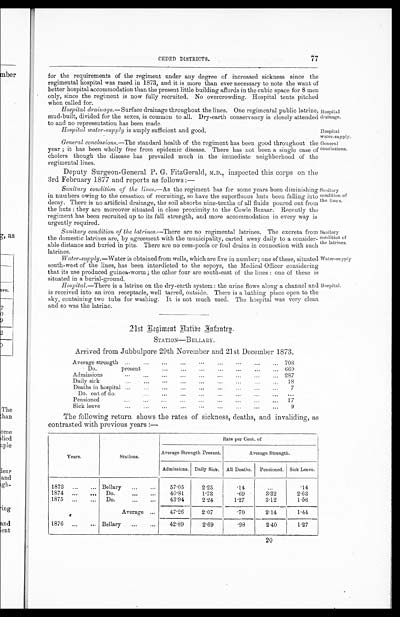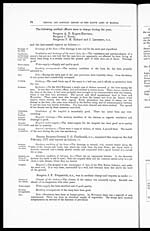Medicine - Institutions > Army health reports and medical documents > Medical and sanitary reports of the native army of Madras > Medical and sanitary report of the native army of Madras for the year 1876
(86) Page 77
Download files
Individual page:
Thumbnail gallery: Grid view | List view

CEDED DISTRICTS.
77
for the requirements of the regiment under any degree of increased sickness since the
regimental hospital was razed in 1873, and it is more than ever necessary to note the want of
better hospital accommodation than the present little building affords in the cubic space for 8 men
only, since the regiment is now fully recruited. No overcrowding. Hospital tents pitched
when called for.
Hospital
drainage.
Hospital drainage .—Surface drainage throughout the lines. One regimental public latrine,
mud-built, divided for the sexes, is common to all. Dry-earth conservancy is closely attended
to and no representation has been made.
Hospital
water-supply.
Hospital water-supply is amply sufficient and good.
General
Conclusions.
General conclusions. —The standard health of the regiment has been good throughout the
year; it has been wholly free from epidemic disease. There has not been a single case of
cholera though the disease has prevailed much in the immediate neighborhood of the
regimental lines.
Deputy Surgeon-General P. G. FitzGerald, M.D., inspected this corps on the
3rd February 1877 and reports as follows:—
Sanitary
condition of
the lines.
Sanitary condition of the lines. —As the regiment has for some years been diminishing
in numbers owing to the cessation of recruiting, so have the superfluous huts been falling into
decay. There is no artificial drainage, the soil absorbs nine-tenths of all fluids poured out from
the huts: they are moreover situated in close proximity to the Cowle Bazaar. Recently the
regiment has been recruited up to its full strength, and more accommodation in every way is
urgently required.
Sanitary
condition of
the latrines.
Sanitary condition of the latrines. —There are no regimental latrines. The excreta from
the domestic latrines are, by agreement with the municipality, carted away daily to a consider-
able distance and buried in pits. There are no cess-pools or foul drains in connection with such
latrines.
Water-supply
Water-supply. —Water is obtained from wells, which are five in number; one of these, situated
south-west of the lines, has been interdicted to the sepoys, the Medical Officer considering
that its use produced guinea-worm; the other four are south-east of the lines: one of these is
situated in a burial-ground.
Hospital.
Hospital. —There is a latrine on the dry-earth system: the urine flows along a channel and
is received into an iron receptacle, well tarred, outside. There is a bathing place open to the
sky, containing two tubs for washing. It is not much used. The hospital was very clean
and so was the latrine.
21st Regiment Native Infantry.
STATION—BELLARY.
Arrived from Jubbulpore 29th November and 21st December 1873.
| Average strength | 708 |
| Do. present | 669 |
| Admissions | 287 |
| Daily sick | 18 |
| Deaths in hospital | 7 |
| Do. out of do. | ... |
| Pensioned | 17 |
| Sick leave | 9 |
The following return shows the rates of sickness, deaths, and invaliding, as
contrasted with previous years:—
| Years. | Stations. | Rate per Cent. of | ||||
| Average Strength Present. | Average Strength. | |||||
| Admissions. | Daily Sick. | All Deaths. | Pensioned. | Sick Leave. | ||
| 1873 | Bellary | 57.05 | 2.25 | .14 | ... | .14 |
| 1874 | Do. | 40.81 | 1.73 | .69 | 3.32 | 2.63 |
| 1875 | Do. | 43.94 | 2.24 | 1.27 | 3.12 | 1.56 |
| Average | 47.26 | 2.07 | .70 | 2.14 | 1.44 | |
| 1876 | Bellary | 42.89 | 2.69 | .98 | 2.40 | 1.27 |
20
Set display mode to: Large image | Zoom image | Transcription
Images and transcriptions on this page, including medium image downloads, may be used under the Creative Commons Attribution 4.0 International Licence unless otherwise stated. ![]()
| Permanent URL | https://digital.nls.uk/74991562 |
|---|




